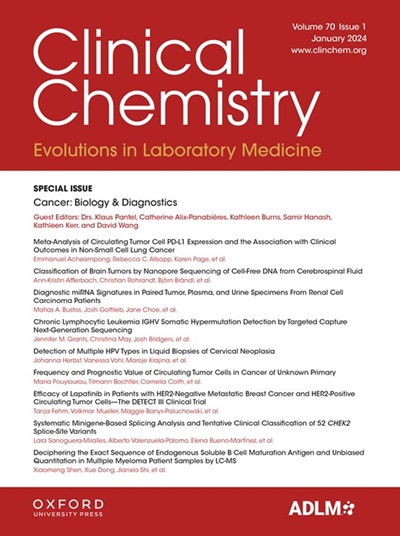Glomerular Filtration Rate (GFR) Estimation with Cystatin C—Past, Present, and Future
IF 7.1
2区 医学
Q1 MEDICAL LABORATORY TECHNOLOGY
引用次数: 0
Abstract
Background Cystatin C is a long-established filtration marker which can be used to assess kidney function, but it has been sparingly used for clinical care due to creatinine’s role as the primary biomarker for kidney function assessment based on estimated glomerular filtration rate (eGFR). Content This review summarizes the evolution of cystatin C’s role in kidney disease assessment and highlights new guidelines promoting more widespread use. Specifically, the 2021 National Kidney Foundation and American Society of Nephrology Task Force on Reassessing the Inclusion of Race in Diagnosing Kidney Disease report, and the 2024 Kidney Disease Improving Global Outcomes (KDIGO) Clinical Practice Guideline for the Evaluation and Management of Chronic Kidney Disease (CKD), recommend increased use of cystatin C as an alternative and complementary biomarker for kidney function assessment, since it does not differ by race like creatinine, correlates better with adverse outcomes compared to creatinine, and provides a more accurate eGFR when used in combination with creatinine. Summary While robust literature demonstrates improved accuracy with cystatin C-based eGFR (eGFRcys) in certain clinical subpopulations, future research is needed to better understand its performance relative to creatinine-based eGFR (eGFRcr) and measured glomerular filtration rate (mGFR) in additional diverse cohorts, and to achieve assay standardization to match the performance of creatinine assays. Additionally, cystatin C testing availability will need to be broadened from primarily reference laboratories to local laboratories, and partnerships will need to be developed between clinical stakeholders and the laboratory to promote cystatin C’s clinical use, to achieve widespread adoption of guideline-recommended eGFR equations.用胱抑素c估计肾小球滤过率(GFR)——过去、现在和将来
胱抑素C是一种长期建立的可用于评估肾功能的滤过标志物,但由于肌酐是基于估计肾小球滤过率(eGFR)评估肾功能的主要生物标志物,因此它很少用于临床护理。本文综述了胱抑素C在肾脏疾病评估中的作用,并重点介绍了促进其更广泛应用的新指南。具体来说,2021年国家肾脏基金会和美国肾脏病学会重新评估种族在肾脏疾病诊断报告中的纳入工作小组,以及2024年肾脏疾病改善全球结局(KDIGO)慢性肾脏疾病评估和管理临床实践指南,建议增加使用胱他汀C作为肾功能评估的替代和补充生物标志物,因为它不像肌酐那样因种族而不同。与肌酐相比,eGFR与不良结果的相关性更好,并且与肌酐联合使用时提供更准确的eGFR。虽然大量文献表明基于胱抑素c的eGFR (eGFRcys)在某些临床亚群中的准确性有所提高,但未来的研究需要更好地了解其相对于基于肌酐的eGFR (eGFRcr)和测量的肾小球滤过率(mGFR)在其他不同队列中的表现,并实现检测标准化,以匹配肌酐检测的表现。此外,胱抑素C检测的可用性需要从主要的参考实验室扩大到地方实验室,并且需要在临床利益相关者和实验室之间建立伙伴关系,以促进胱抑素C的临床使用,以实现指南推荐的eGFR方程式的广泛采用。
本文章由计算机程序翻译,如有差异,请以英文原文为准。
求助全文
约1分钟内获得全文
求助全文
来源期刊

Clinical chemistry
医学-医学实验技术
CiteScore
11.30
自引率
4.30%
发文量
212
审稿时长
1.7 months
期刊介绍:
Clinical Chemistry is a peer-reviewed scientific journal that is the premier publication for the science and practice of clinical laboratory medicine. It was established in 1955 and is associated with the Association for Diagnostics & Laboratory Medicine (ADLM).
The journal focuses on laboratory diagnosis and management of patients, and has expanded to include other clinical laboratory disciplines such as genomics, hematology, microbiology, and toxicology. It also publishes articles relevant to clinical specialties including cardiology, endocrinology, gastroenterology, genetics, immunology, infectious diseases, maternal-fetal medicine, neurology, nutrition, oncology, and pediatrics.
In addition to original research, editorials, and reviews, Clinical Chemistry features recurring sections such as clinical case studies, perspectives, podcasts, and Q&A articles. It has the highest impact factor among journals of clinical chemistry, laboratory medicine, pathology, analytical chemistry, transfusion medicine, and clinical microbiology.
The journal is indexed in databases such as MEDLINE and Web of Science.
 求助内容:
求助内容: 应助结果提醒方式:
应助结果提醒方式:


